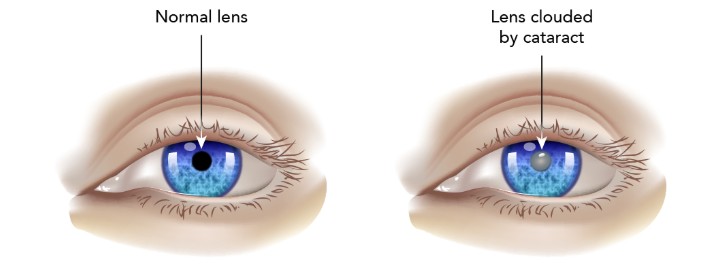
What Is A Cataract?
A cataract is a clouding of the lens in the eye, which is typically clear. This cloudiness can develop slowly over time, leading to blurred vision and difficulty seeing. Imagine looking through a frosty or fogged-up window—this is what vision can feel like for someone with cataracts. Globally it is the leading cause of blindness; in the United States over half of all Americans will either have cataracts or undergone surgery to treat them by age 80.

How Does It Impact Vision?
Cataracts can significantly affect one’s ability to see clearly. Symptoms include clouded, blurred, or dim vision, trouble seeing at night, sensitivity to light and glare, and seeing “halos” around lights. As the cataract progresses, it can make daily activities like reading, driving, or recognizing faces challenging.

What Can People Do When They Have Cataracts?
Initially, stronger lighting and eyeglasses can help manage the symptoms of cataracts. However, if impaired vision starts to interfere with daily activities, cataract surgery might be necessary. This procedure involves removing the clouded lens and replacing it with a clear artificial lens. Cataract surgery is generally safe and effective, with about 97-98% of patients experiencing significantly improved vision post-surgery, often 20/40 vision or better within 90 days!
What Happens When Traditional Options Are No Longer Available?
When traditional options like surgery are not viable, individuals may need to explore alternative methods to manage their vision. This is where low vision services from Future In Sight come into play. Our low vision trained Occupational Therapists specialize in helping people maximize their remaining vision through various techniques and tools.
What Can They Do To Help?
Low vision occupational therapists come to your home to provide personalized strategies to help individuals adapt to their vision changes. They might recommend magnifying devices, specialized lighting, or adaptive techniques for daily tasks. Their goal is to enhance the quality of life for those with vision impairments, ensuring they can continue to perform everyday activities with greater ease, independence and safety.
In conclusion, while cataracts can be a challenging condition, there are numerous ways to manage and treat it. From surgery to low vision strategies, individuals have options to maintain their quality of life and continue enjoying the world around them.
If you or someone you love is experiencing vision loss and could benefit from our services, please contact Future In Sight at [email protected] or 603-224-4039 today!
About the Author: Christelle Gonzales, MOT, OTR/L, LSVT, CHC is an Occupational Therapist at Future In Sight

